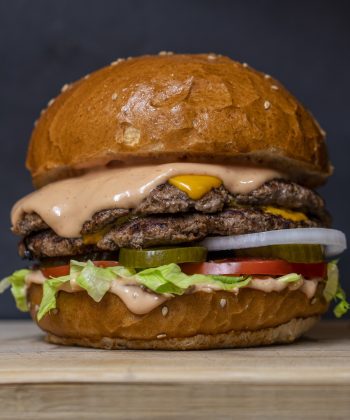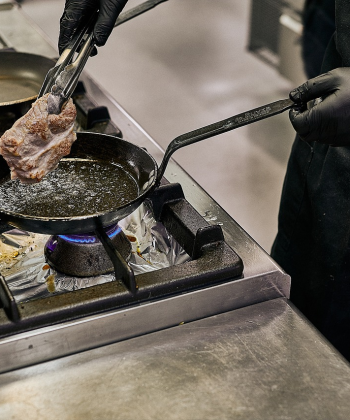It’s about 3 times leaner than grain-fed beef and packed with higher omega-3 and omega-6. It’s also more nutritious and full of vitamins you won’t find in grain-fed beef. It’s what people ate for thousands of years before cattle were crammed into big, dirty feedlots.
We could go on forever about it!
Cooking grass-fed beef is slightly different from what you might be used to. It’s leaner and has a bold, earthy flavor that feedlot beef just doesn’t have.
But don’t worry—we’ve got you covered. Here are our top 8 tips for cooking grass-fed beef!
Know the Freeze/Thaw Cycle
A strong taste profile is what you get with grass-fed beef, but improper freezing can ruin it. You want to taste that beefy flavor, not freezer burn.
Air exposure is the top reason for freezer burn. Always wrap the meat tightly, vacuum sealing if possible.
If you don’t have a vacuum sealer, use freezer paper pressed tightly against the meat, then place it in a ziplock bag, pressing out all the air before freezing.
Thaw meat in the refrigerator, never in the microwave. Microwaving causes uneven thawing and can alter the flavor. A 1lb package takes about 24 hours to thaw.
Before cooking, let the meat sit out for 30 minutes to reach room temperature. It browns much better at room temp than when cold.
Start Small with Seasoning
Remember, one of the biggest advantages of using grass-fed beef is that it is tender and flavorful. So, when it comes to seasoning, it is best to start with a little. Sometimes, all that is required to make a good grass-fed steak is some salt and pepper.
Marinades are fine as long as they do not mask the flavor of the meat. They are most effective when they help increase the water content, as grass-fed beef is leaner than grain-fed beef. One can add onions and peppers to enhance the taste and increase the moisture content of grass-fed burgers.
Instruction:
Grass-fed beef mince is a lean cut of meat, so it’s important to cook it properly to prevent it from drying out. When grilling, don’t overcook it. Aim for medium doneness and use a meat thermometer to avoid dryness. For those thicker cuts, consider reverse searing to lock in moisture and enhance flavor.
If you’re baking or roasting, plan ahead and don’t under-season your meat! Higher-fat cuts can hide dryness, so choose leaner cuts when baking and consider adding moisture with sauces or marinades when roasting.
When it comes to ground beef, don’t crowd the pan! Overloading your skillet can lead to steaming instead of browning. Mix some ground pork or veal for added moisture and flavor for a juicy burger.
Be Aware of Fat Content
Grass-fed cattle roam more than feedlot cattle, which means their meat is naturally leaner. Try using good-quality olive oil to add rich flavor while cooking. Sear the meat in it to get a nice, golden crust, or drizzle some on before popping it into the oven or slow cooker. It’s an easy way to boost the flavor!
Pink is Good
If you are the type of person who likes meat well done, then it is time to change your ways. Grass-fed beef is a lean meat and does not do well when cooked for long periods. Do not overcook steaks; the ideal doneness should be medium!
If you want your burgers to be more on the well-done side, there are a couple of tricks that you can try: You can marinate the meat or add some moist vegetables to the minced meat. Also, brush them with butter during their preparation to retain moisture and enhance taste. If there is still no changing your mind and you still want to have well-done meat, then take it out of the freezer. Low and slow cooking helps retain the moisture and thus makes the meat very soft.
Watch Your Cooking Time & Temps
One must be careful with the time and temperature when using grass-fed beef.
All ovens and stovetops are different, so it may be difficult to find how your particular oven/stovetop handles grass-fed meat at first. However, it is generally tender and juicy and takes about one-third less time to cook than conventional beef.
Although you should not overcook the grass-fed beef, ensuring the pan is very hot before putting the meat in it is crucial. Do not turn your back while it is on high heat because you do not want your meat to become dry.
Thus, the meat will continue to cook for some time, even after it has been removed from the heat. To check the inside, use a thermometer; the temperature should be between 130 and 140 degrees for medium rare.



